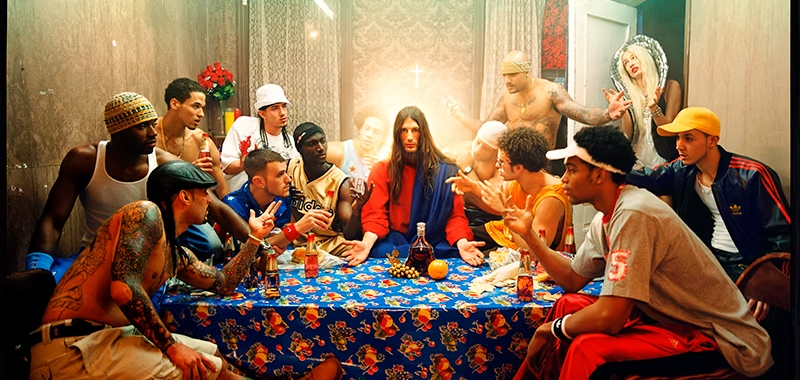Outrageous, Iconic, Unforgettable: A Deep Dive into David LaChapelle's Art part 1
- Dr. Freezze

- Jun 19
- 7 min read
David LaChapelle's fusion of fine art, pop culture, and provocative themes has cemented his place as a truly unique and influential voice in photography. His distinctive gallery-like images continue to inspire, challenge and captivate. From his high-impact celebrity portraits to his deeper, art-history-infused contemporary pieces, LaChapelle has arguably become one of the defining visual artists of our generation. As such , we're diving deep into the career of this iconic photographer, exploring his journey and taking a closer look at the incredible techniques behind some of his most unforgettable and well-known images.
Personal & Professional Profile
David LaChapelle was born on March 11, 1963, in Hartford, Connecticut. His first photograph was of his mother, Helga, on a family vacation in Puerto Rico. LaChapelle often credits his mother for influencing his art direction through the way she set up scenes for family photos in his youth. Young David would drop out of high school at just 15 years old, run away to New York, and find work as a photographer at the iconic Studio 54. He would get his first big break when Andy Warhol encountered him at the infamous nightclub and was so impressed by his work that he hired LaChapelle as a contributing photographer for Interview Magazine (Estiler 2020).

LaChapelle's early works can often be described as satirical, outrageous, and, in some respects, bizarre. His earliest photo sets featured him placing well-known characters in unusual settings. An example of his unique approach is a set of photographs known as the "Jesus is my Homeboy" (2003) series, in which LaChapelle depicts Jesus among marginalized and demonized social groups. Even though he has had a significant impact on fine-art photography through his signature mix of color with conceptual imagery, today LaChapelle is well known for his iconic celebrity photoshoots and for directing music videos for pop stars.
In 2006, then at the peak of his career, LaChapelle quit commercial photography and moved to Maui, Hawaii. Referring to his time off, LaChapelle said, “I love glamour and fashion and beauty – that has been with civilizations forever, but I needed to get away from the propaganda of that. When I quit everything, I never wanted to shoot another pop star as long as I lived.” He later returned to commercial photography in 2009, working with the likes of Lady Gaga and Kanye West. LaChapelle also re-entered the fine art world in 2011, putting on his long-awaited international exhibition. His contemporary work often references art history and religion and conveys social messages. His photographic style can be best described as "hyper realistic" and "pop surrealism." LaChapelle has an extensive resume working with international publications, and his photos have been exhibited in commercial galleries and institutions worldwide. LaChapelle’s work frequently appears on the covers and pages of magazines such as GQ, Vogue, Rolling Stone, Vanity Fair, and The New York Times.
Frequent Collaborators & Inspiration
His most notable collaborator and muse is American transgender model Amanda Lepore. LaChapelle first photographed Lepore depicted as Andy Warhol's Marilyn Monroe portrait. Throughout their frequent collaborations, “they have explored the boundaries between female and male bodies as well as between fashion and art” (Markiewicz 2021).
LaChapelle is heavily influenced by his late mentor and pop art icon Andy Warhol. He also references art history, particularly the painter Théodore Géricault and Italian Renaissance artist Michelangelo. Much of his work is also shaped by his upbringing and life as a gay man in the late 1980s.
Kissing Sailors – Diesel (1995)

An example of an early notable LaChapelle photo is his 1995 collaboration with the Italian denim brand Diesel, titled “Kissing Sailors.” The photograph depicts two male sailors kissing in front of a diesel-powered American submarine. The photo itself takes heavy inspiration from the historic 1945 V-J Day photo by Eisenstaedt, “Kiss in Times Square.” The ad was created shortly after “the Clinton administration instated Don’t Ask Don’t Tell, a policy that banned openly LGBT+ people from serving in the U.S. military” (I-D 2017). Another significant aspect of “Kissing Sailors” was that it was “an international campaign and one of the very first to portray a same-sex kiss in 72 countries around the globe” (Danny with love 2019). Like its 1945 counterpart, “Kissing Sailors” evokes a sense of patriotism, excitement, and passion. The frame is filled with celebrating spectators, soldiers, and nurses. Additionally, like Eisenstaedt’s original photo, the mood conveyed is meant to be wholesome and ecstatic, creating a snapshot of a triumphant moment in time. The two male models in LaChapelle’s photo are real-life former couple Bob and Rod Jackson-Paris. Although both men are “dressed as sailors, there is a clear indication that the man on the left is the more, ‘feminine’ one in the relationship” (Reed 2019). (Figure 2: Kissing Sailors, Diesel advertisement (1995)) His “masculine” partner, on the other hand, “stands with a broad back and bulging triceps, leading his submissive partner into the kiss” (Reed 2019). LaChapelle’s subjects are posed naturally, rather than in the staged and posed style typical of campaign photography involving knowing subjects. In an interview with ID magazine later in his career, LaChapelle stated when referring to the photograph: “We didn’t do it to win awards or anything. At the time, what was being questioned was if openly gay people should be allowed to serve in the military. I just wanted to make a statement commemorating that gay people had been in the military since there ever was a military. Not only should we ‘allow them’ in, but we should also thank them. That’s what Diesel did and allowed me to do” (I-D 2017).
Kanye West – Rolling Stone (2006)
The photo set, with images individually titled “Passion of the Kanye West” and “The Cross I Bear” (2006), shot for Rolling Stone magazine, marked the first of many collaborations between David LaChapelle and Kanye West. In the first photo, we see Kanye dressed as Jesus himself, complete with a crown of thorns and cuts and bruises to his face. The second photo shows Kanye as himself, holding a giant cross and wearing two “Jesus piece” chains. This perhaps draws on the complex idea of God living through his creations or as a reflection of His earthly creations. From his breakout single “Jesus Walks,” released in 2004, which went on to win a Grammy for Best Rap Song (Heigl 2019), to his 2013 album Yeezus, Kanye does not shy away from his Christianity. In later years, he went as far as calling himself a god. In a 2014 interview with Flatt magazine, the famed photographer asserted that the concept for the shoot was his idea, not Kanye’s. West is far from the only celebrity to receive Christ-like treatment from LaChapelle; the list includes figures like Michael Jackson. It can also be assumed that the photo is an updated take on his "Jesus is my Homeboy" (2003) photo series. The photographer has merged his earlier metaphysical concerns with his depiction of celebrity culture to grapple with social and political concerns within the context of religion, which, in his own words, he believes “has been hijacked by extremist views” (EFE 2019). On his use of religious iconography, LaChapelle states, “When I depict Jesus as a black man in my work it is not to provoke people; it’s to talk about this idea of this greatest loss.” He then goes on to add, “I am not trying to provoke in the religious sense. I like to provoke thought, but not provoke to upset people” (EFE 2019). The Rolling Stone cover drew heavy criticism at the time of its release, with some even labeling it blasphemous. In recent years, however, it has gained cult status, becoming a fan favorite. Unfortunately, little is known about the production crew involved with the aforementioned cover photo. LaChapelle and Kanye would collaborate twice more, once in 2006 and again in 2009, each time producing unique imagery.
Astroworld – Travis Scott (2018)
For his 2018 album Astroworld, Travis Scott enlisted the help of LaChapelle to create two album covers: one for the general release and another for the deluxe version. The covers pay homage to the now-defunct Texas theme park Astroworld, which used to be a frequent hangout spot for Scott until its closure in 2005. The daytime version of the album art shows a group of happy children enjoying themselves in the foreground, with a family seen in the background entering through a large, gold, inflated Travis Scott head. There is an old, abandoned car on the right-hand side with a custodian cleaning around it. On the left-hand side of the image is a rocket with an Astroworld globe. The nighttime cover also features the gold Travis Scott head, in addition to nude models pictured in provocative poses (EECKELS 2019). The car from the daytime version is now on fire; everything is darker, more broken, and enticing. The daytime amusement park seemingly transforms into a freak show of some sort. Overall, the Astroworld covers are otherworldly, full of color, and feature a wide depth of field where every element is in focus, giving the image a surreal feel. The covers do not look like typical rap album covers but more like dioramas. It is important to mention that the artwork briefly attracted criticism shortly after its release, “due to the discovery that the trans model and frequent collaborator of LaChapelle Amanda Lepore was edited out of the final version” ([5orry 2018)

As we've seen, David LaChapelle is a true visual provocateur, consistently pushing boundaries and crafting unforgettable narratives within single frames. The iconic works we've explored today are just a glimpse into his vast and vibrant contribution to fashion and art photography.
And if you're as captivated as I am, you're in luck! This is just the first chapter. Be sure to join me for Part 2, where we'll unwrap three more compelling pieces from LaChapelle's extensive collection, continuing our journey through his audacious and brilliant career. What elements of his style are you most excited to see more of? Let me know in the comments, and look out for the next post!"
References : Danny with love 2019, ‘David LaChapelle: Queer Culture Pioneer’ Danny with love, Viewed 29 March 2022,
https://www.dannywithlove.com/blog/david-lachapelle-queer-culture-pioneer
EFE, 2019,’ American photographer David LeChapelle aims to provoke thought, not religion’, EFE, viewed 29 March 2022,
https://www.efe.com/efe/english/entertainment/american-photographer-david-lechapelle-aims-to-provoke-thought-not-religion/50000264-3928358
Estiler, K 2020, ‘David LaChapelle to Discuss Career and Inspirations in Upcoming PAMM Virtual Talk’, Hypebeast, viewed 25 March 2022,
https://hypebeast.com/2020/7/david-lachapelle-franklin-sermons-perez-art-museum-miami-virtual-conversation-info
Eeckels, P 2019, ‘David LaChapelle’s 4 most inspiring works ‘, Enfntsterribles, viewed 26 March 2022
https://enfntsterribles.com/david-lachapelle-4-inspiring-works/
I-D, 2017, ‘David LaChapelle on the positive power of advertising’ , I-D , viewed 29 March 2022,
https://i-d.vice.com/en_uk/article/evx4de/david-lachapelle-on-the-positive-power-of-advertising
Iqbal, N 2019, ‘Photographer David LaChapelle: ‘I never wanted to shoot another pop star – I was tortured by them’, The Guardian, viewed 26 March 2022
https://www.theguardian.com/artanddesign/2017/nov/21/david-lachapelle-photographer-hawaii-warhol
Markiewicz, M 2021, ‘David LaChapelle Biography’, Ocula, viewed 25 March 2022,
https://ocula.com/artists/david-lachapelle/
Reed, 2019,’ Romance Analysis: Diesel Jeans’, Reed, viewed 27 March 2022,
https://www.reed.edu/anthro/adprojects/2011/greaves_mercado/DieselAnalysis.html
Walters, A 2019, ‘David LaChapelle, Kanye West and the pop-cultural appeal of religion’, Sleek, 28 March 2022,
https://www.sleek-mag.com/article/david-lachapelle-kanye-west/
5orry, 2018, ‘The artist who designed the Astroworld cover: David LaChapelle’ , 5orry, viewed 29 March 2022,





















Comments